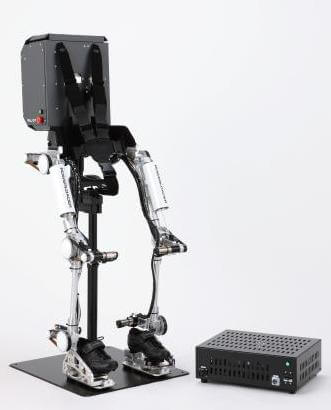
If you’re like me you grew up on cartoons and scifi books with heroes that fought evil in robotic walking battle suits. You probably imagined that one day in the future you’d be riding around in one of those exoskeletons kicking butt and taking names. Well, that day is half way here, but even a reduced version of your dream isn’t going to come cheap. Active Link, an offshoot of Panasonic, has officially announced that it will be selling a lower body exoskeleton that will augment your carrying capacity by up to 40 kg (88 lbs). The Power Loader Light (PLL) has a price tag of ¥18 million or around $230,000 USD. That’s a little outside my budget, but if you’re a researcher in human-machine interaction or brain-machine-interfaces, you could qualify for the sales price of just ¥9 million. I doubt many will purchase the PLL for home use, but that 50% discount may mean Active Link’s exoskeleton could become a popular platform for scientific research in the near future.
The Power Loader Light is a stripped down version of Active Link’s full body exoskeleton called, you guessed it, the Power Loader. That complete robotic suit has huge claw like arms and can increase lift by 100 kg (220 lbs). It’s also nowhere near ready for market. By stripping out the arms, the PLL focuses simply on transferring weight from the operator to the legs of the exoskeleton. The motorized limbs can bear their own weight (a considerable 38 kg) and provide an additional 400 N (40 kg or 88 lbs) of upwards force at slow speeds. For a commercially available device, that’s pretty awesome.

To put that in perspective, however, it’s less than half what the HULC exoskeleton can handle. The HULC, developed for the US Army by Lockheed Martin, can lift 200 lbs (91 kg) and is looking to develop a battery that will let it run for 72 hours. No news yet on how long the PLL can move between charges. Of course, there’s also no news on the price of the HULC; it could end up costing millions. A better comparison for the PLL may be the Rex exoskeleton designed to help paraplegics walk on their own. The Rex retails for around $150,000, but relies on its operators using joysticks to control its movements. The PLL uses six-axis force sensors in the pedals to anticipate where the user wants to go (the HULC has a similar control scheme).
The more I think about it, the more I believe that Active Link’s exoskeleton is probably best suited to stay in the lab. Research groups can use the walking platform to explore how humans and machines interact and help design the next generation of robotic suits. The PLL runs on Linux 2.6, so it should be flexible enough for scientists to experiment with new control schemes, maybe even direct brain interfaces. Then there’s the 50% discount that Active Link is offering. I’m sure that will be pretty enticing.
Whenever I see a press release about an exoskeleton I get really excited. Those childhood dreams about mecha suits keep jumping to the front of my mind just in time for reality to bat them back down. The truth is that the PLL, HULC, Rex, and other exoskeletons we’ve seen are all cool looking, but much too expensive to be available to the average person. They aren’t amazing enough (where are the lasers, goddammit!) to justify their purchase as a luxury toy, and they aren’t cheap enough to be used in industry or medicine. The latter is the real crime. Cheap medical exoskeletons could make a big impact in the care of the elderly. A nurse could use a robot suit to lift a patient, or a debilitated patient could wear one to help them live a normal life. Modern exoskeleton technology simply isn’t there yet. (Even the Rex seems mainly suited to young healthy adults who just happen to be paraplegic). But give it time. As we discover better batteries and more efficient motors, the power of these robotic suits will only increase. For now the PLL should stay in the lab, but the dream of your own personal robot suit lives on.
[image credits: Active Link]
[source: Active Link PLL Release (PDF in Japanese)]


